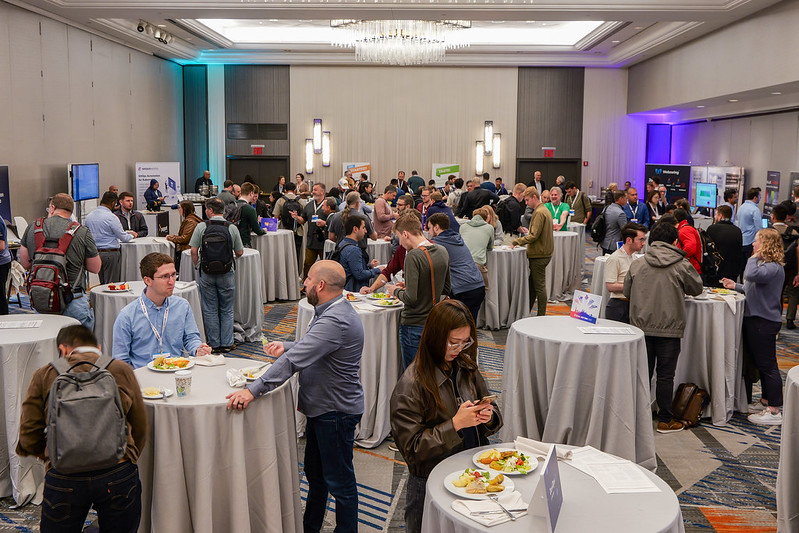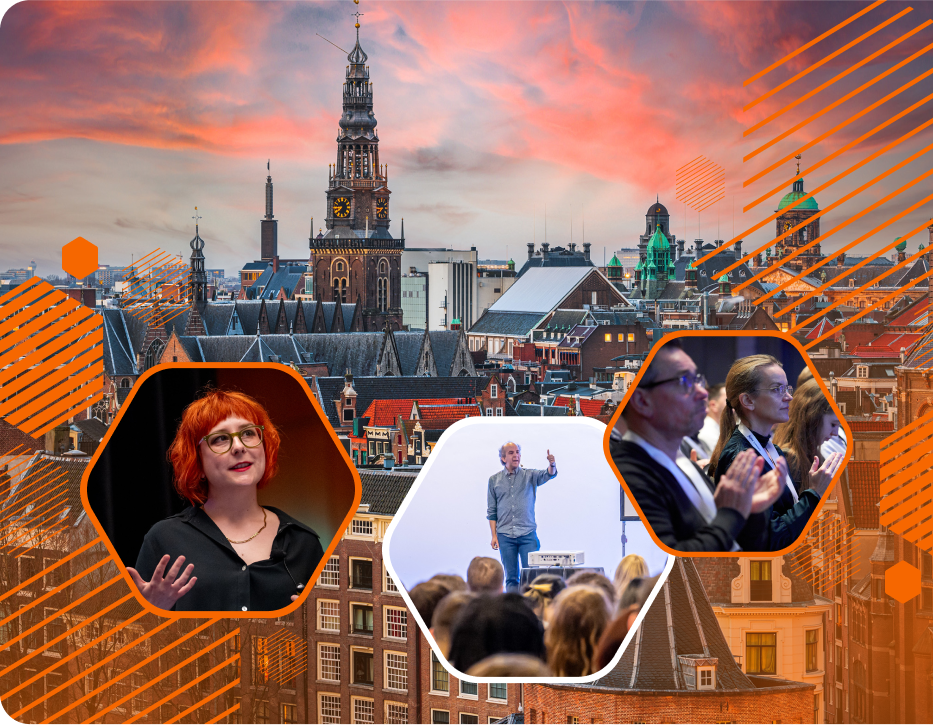- Program
- Program
- Schedule
- Business, Leadership & Organization
- Cloud Platforms & Infrastructure
- DevSecOps
- Kubernetes & Cloud Native
- CI/CD: Automation & Delivery
- System Design & Software Architecture
- Observability & Reliability
- DevOps Transformation Day
- Platform Engineering Summit
- Kubernetes Bootcamp
- Advanced Kubernetes Bootcamp
- DevSecOps Days
- Speakers
- More Program
- Program
- Program
- Call For Papers
- Program
- Program
- Program
- Tickets
- Tickets
- Tickets
- Tickets
- Tickets
- Tickets
- Tickets
- Program
- Formate
- Inhouse
- Blog
- Info
- DevOpsCon
- Downloads
- Sponsors & Expo
- Sponsors & Expo
- Info
- Camps
- Editions
- Jetzt anmelden
- Register Now
- Register Now
- Register now
- Register Now
- Register now
- Register now
- Register Now
Devopscon Spring 2018

DevOps Transformation Day: Everything you need to succeed [SOLD OUT]
DevOps is much more than than just local improvements in the development, delivery and operation of software: it represents a movement which touches not only development and operations (obviously!), but organizational culture, quality assurance, security, and program management.
This workshop is a compact one-day briefing for DevOps beginners and those who’d like to get a comprehensive overview of the complex, encompassing DevOps landscape. It is tailored for technical stakeholders as well as for business leaders. Anyone tasked with a DevOps transformation will be able to spend a day wrapping their head around the world of DevOps, with exercises to help them look at their specific organization’s challenges through a DevOps lens. In the workshop, we’ll cover the following topics:
- DevOps history and underpinnings
- Core DevOps principles
- Continuous delivery and business flow
- An overview of technologies and tools to help implement DevOps
By joining DevOpsCon’s Transformation Day, you’ll get an insight into all the necessary aspects to make a DevOps transformation in your own organization successful.

Workshop: Using Kubernetes [SOLD OUT]
In diesem Workshop werden wir uns nicht lange mit der Installation eines Kubernetes Clusters beschäftigen. Als Teilnehmer benötigen Sie lediglich einen Git Client und das kubectl Binary. Wir beschäftigen uns mit den wichtigsten Kubernetes-Objekten, um eine eigene Applikation im Kubernetes-Cluster auszurollen. Wir werden folgende Objekte kennen lernen:
- Pods
- Deployments
- Services
- Secrets/Configmaps
- PVC/PV
Die fehlenden Objekte werden vorgestellt. Die Teilnehmer lernen, wie eine eigene Applikation in einem Kubernetes Cluster ausgerollt werden kann. Rolling Upgrades und Canary Deployments sind am Ende ein Leichtes! Auch wird vermittelt, warum Entwickler nicht mehr als den Zugriff zu einem Kubernetes Cluster brauchen, um ihre Applikation zu monitoren (Log/Metrik/Verfügbarkeitsmonitoring mit Prometheus und Elastic).

Workshop: From Zero to Continuous Integration and Continuous Delivery [SOLD OUT]
Continuous Integration (CI) and Continuous Delivery (CD) are development practice of applying small code changes frequently. It's well known that it becomes more and more essential to any agile-based organization. This workshop will help you to understand the CI/CD concepts, mindset, and how to implement the practices that help to form the DevOps culture to implement CI/CD for software development. We will go over Git and GitHub, Maven basics and Jenkins installation and configuration. The final goal is to have a CI/CD process on a "Hello World" project that runs for each change in a Github.com demo repository. This workshop is mainly for:
- Software Developers and Test Engineers
- Scrum Masters, Product Owners
- Whoever is interested to know about implementing CI/CD

Collaborative Problem Solving for DevOps
DevOps can have huge impact in scaling organizations and making them more adaptive to change and thus resilient. To work this angle, we need the ability to pick the right problems, view them from diverse angles and then collaboratively solve them. No solution thought out by a single person or department will help and stay or will even be close to ideal. Therefor we need to find ways to understand and solve problems in groups of diverse people. It turns out that the discipline of design is doing that since ages and provides valuable tools.
In this workshop, we will throw the tools of Design and Design Thinking on problems you want to solve in your DevOps environment. You can bring those problems to the workshops that keep you stuck right now. Here is how we will work in this all hands-on workshop:
A group of max. 20 DevOps people will work together on 5 self-chosen problems in 5 teams.
Collection of valuable problems to solve that matter to you
Prioritization and choice of problems we will work on
Forming of teams
Working on the understanding and framing of the problems: Wording of a problem statement
Ideation on the defined problem in a highly iterative, time boxed process incl. Exchange and pitching of solution ideas, rinsong, repeating and hardening emerging solutions.
Presentation of solutions.
The aim of the workshop is not the complete solution of all the problems addressed but finding valuable solution directions and sharing the experience of a team-based, iterative solution approach that makes a difference. This should enable you to transfer this process to your everyday work environment.

Workshop: Winning at DevOps with Kanban [SOLD OUT]
Most DevOps initiatives begin with a heavy focus on improving the flow of work through the CI pipeline. That’s important, but it’s just one component of a larger system at work. Kanban is a flow-based approach that can be applied to a specific team or an entire value stream. The goal of Kanban is to force issues to the surface so we can improve our system, allowing us to complete work more easily. Continually finding and fixing problems hones our system to support work delivery and not prevent it. In short, you learn how to get more done with less stress and the same people and resources. In addition, you’re building a culture of learning while doing that, when spread across an organization, significantly boosts your agility and competitive advantage. In this workshop you’ll learn to tame the chaos through:
- Visualizing your work in its workflow
- Applying enabling constraints like work-in-process limits and explicit policies
- Experiencing the difference between push systems and pull systems
- Identifying signals of system problems and designing experiments to solve them
This is a full-day, interactive workshop is for people new to Lean and Kanban. You will experience the thinking process that guides the visualization of your work and work processes, highlights internal and external pain points, and establishes pull and flow. Games, exercises and discussions will be used throughout the workshop to explore topics in detail. You will receive a certification of course completion at the end of the day.

WebGoat-Workshop: Teaching Application Security 101
A good defense against insecure code requires understanding the mechanics behind how attackers exploit simple programming mistakes. The WebGoat team will walk through exercises like SQL Injection, XSS, XXE, CSRF, ... and demonstrate how these exploits work. We will show you how you can use WebGoat to train your developers to avoid these simple but common programming mistakes. We also show you how to extend WebGoat to create lessons specific to your environment. Join us to learn the most basic, but common, application security problems. Tired of all the lessons? During the training we will host a small CTF competition which you can take a shot at and compete with each other.

Welcome Keynote and Conference Opening
Sebastian Meyen, Program Chair, welcomes all attendees, introduces this year’s program and gives last details about DevOpsCon 2018.

Observability for emerging Infra: what got you here won't get you there
Distributed systems, microservices, containers and schedulers, polyglot persistence ... modern infrastructure patterns are fluid and dynamic, chaotic and transient. So why are we still using LAMP-stack era tools to debug and monitor them? Let's talk about the industry-wide shifts underway from metrics to events, from monitoring to observability, and from caring about the system as whole to the health of each and every request, and every user's experience.


100 Ideas to bring DevOps into an Organization
While bringing DevOps into a traditional organization, we generated many ideas and received ideas from other companies. This session is the occasion to share this catalog of ideas as well as the feedback and experience collected on some of them.

Kubernetes Patterns
The way we design, develop, and run applications on cloud native platforms like Kubernetes differs significantly from the traditional approach. When working with Kubernetes, there are fewer concerns for developers to think about, but at the same time, there are new patterns and practices for solving every-day challenges. In this talk, we will look at a collection of common patterns for developing cloud native applications. These patterns encapsulate proven solutions to common problems and help you to prevent inventing the wheel again. After a short introduction into the Kubernetes platform we will look at the following pattern categories:
- Foundational patterns which build the basis of the Kubernetes platform
- Behavioral patterns describe concepts for different types of applications
- Structural patterns are for structuring your cloud native application
- Configuration patterns provide various approaches to application configuration
In the end, you will have a solid overview how common problems can be solved when developing cloud native application for Kubernetes.

Es muss nicht gleich Docker sein – IT Automation, die zu einem passt
Docker ist in aller Munde und wird gerne als Allheilmittel für Deployment-Probleme propagiert. Das führt zu der Annahme, automatisierte Deployments seien nur mit Docker möglich, obwohl Provisionierungswerkzeuge wie Ansible Lösungen außerhalb der Containerwelt anbieten. Deren Einsatz wird oft gar nicht in Betracht gezogen, weil irgendwann in ferner Zukunft doch einmal Docker im Unternehmen eingesetzt werden soll. Die Automatisierung wird immer weiter verschoben, weil der Aufwand in einem Schritt zu groß ist, obwohl Ansible mit wenig Mühe in der Gegenwart helfen könnte. Die Verwirrung wird dadurch vergrößert, dass die Einsatzszenarien von Provisionierungswerkzeugen und Containertechnologien fälschlicherweise vermischt und somit als Konkurrenz betrachtet werden.
Dieser Vortrag erklärt anhand von Ansible und Docker, worin sich ein Provisionierungswerkzeug von einer Containertechnologie unterscheidet. Es wird gezeigt, wie Ansible auf dem Weg zu einer Dockerisierung der Infrastruktur jetzt schon Probleme lösen kann und wie ein gemeinsamer Einsatz beider Technologien die Vorteile beider Welten kombiniert.

A Software Architect's View on digital Product Design
Over the last few years, a disruption has been going through our markets. It has often been described with the buzzword "digital transformation". In this presentation I would like to examine the topic from a software architect's point of view. We will look at the questions "What is the nature of this disruption? What examples are already shaping our daily lives? What actually are digital products? How do these products change our everyday life, though we're hardly aware of it? What do people actually mean when they say "The digital age has a new currency" and what does that mean for me?" We'll talk about what we as software architects are paying attention to in order to make our products and software systems fit for the digital age and why a proper software delivery process is so important in that regards.

Eat your own Dogfood: Design of a CD Platform from the Point of View of a Software Architect
We design systems for the business departments by using Empathy Maps to understand the customer and his needs. We carry out Event Storming to develop common process understanding. We really want to understand the problem. But which development team applies these methods to the design of its own continuous delivery processes and platform? We show how these design techniques can be used to develop tailor-made solutions and what different platforms we have encountered in our consulting practice.


Seven Ways to turn DevOps into ChatOps
Learn seven ways you can make DevOps teams more productive by integrating workflows and automation into your organization messaging solution. From both our internal team at Mattermost and working with customers like Samsung, Uber and Funke Mediengruppe, I have seen amazing examples turning DevOps workflows and processes into ChatOps.


DevOps for the Automotive Industry
Coming from a modern, lean, DevOps orientated world into an "old fashioned" industry always leads to surprises. This talk tells the story of our engagement with the software engineering departments of the German automotive industry. It’s not surprising that DevOps is not something they think about a lot - it simply doesn’t work out of the box. Regulations, organizational differences and scope of the projects differ from those in the IT industry. So we started to find out which elements of modern workflows can be taken into the automotive industry and started implementing them. This talk covers lessons we learned, tooling we used, suggestions for companies willing to use DevOps, facilitate processes with Embedded Linux and an innovative solution to that pesky Open Source licence compliance problem.

Need for Speed - Challenges on the Transformation Journey of an IT Service Provider becoming a DevOps Company
The rise of agile and lean methodologies, new architectural patterns for distributed systems, the vast explosion of automation technologies and the literal endless possibilities of cloud services have changed the rules of IT Service Providers like DB Systel. Companies which are able to combine these trends in a meaningful way will end up in a DevOps production model and gain significant improvement in quality and time-to-market. In his talk, Dr. Martin Strunk will point out how DB Systel tries to transform its development and operation delivery into a DevOps model and gives a few examples for the major challenges related to this transformation.

Kubernetes-Architektur 101
Dieser Talk ist kein reiner Hands-on. Worum geht es? Es wird der Aufbau von Kubernetes erklärt. Was ist ein Kubelet, Api-Server etc. und wie kommunizieren diese und ermöglichen es, unsere (Micro)Services/Container zu betreiben? Am Ende der Session soll klar sein, wie Kubernetes funktioniert und warum wir Kubernetes nicht nur als Orchestrator, sondern als unsere neue und ausschließliche Infrastruktur für Docker sehen sollten. Buzzwords:
- etcd
- controller-manager
- api-server
- scheduler
- kubelet
- kube-proxy
- DNS
- Monitoriing/Logging
- ingress
- Pods/Cron[Jobs]
- Services

Microservice Authentication and Authorization
In this talk we will look at how you can secure your microservices, we will identify the difference between authentication and authorization and why both are required. We will investigate some common patterns for request validation, including HMAC and JWT to avoid the confused deputy problem, and also how you can manage and secure secret information. Finally, we will see how we can leverage tools like the open source HashiCorp Vault as well as features from cloud providers like AWS and GCP, to keep your systems and users secure. Takeaways:
- Using JWT for Authz
- How to implement two factor authentication into your applications
- Securing microservice secrets
- Implementing TLS and MTLS
- Securing database access, don't be the next Equifax
- Encryption in transit, secure your data
- Building a secure secret access policy

Finding Metrics that matter and using them safely
Data-driven decision-making is a goal of most leaders today. Unfortunately, between the overwhelming amounts of data available to us and the ease of falling prey to misleading vanity metrics, how to begin this journey can feel extremely elusive.
How do we know what’s important enough to measure? How do we get a holistic picture of organizational health? How do we ensure our metrics help us more than they hurt us? There are many important questions to consider before doubling down on your inventory of metrics.
This interactive presentation will help you ensure you:
- can map your metrics back to your desired goals.
- have a balanced set of metrics to provide a holistic picture of health.
- have calculated the gaming potential of your metrics to ensure the value outweighs the risk.
With these new tools in your arsenal and a better understanding of metrics safety, you can set the stage for smart, data-driven decision-making in your organization.

Conflicting Priorities: How to visualise Impacts to your DevOps Implementation
Are conflicting priorities stealing time away from you? Do important decisions get delayed in your organization because of rescheduled meetings? If people are unavailable when they are needed, competing priorities across teams may be the problem. Your team’s top priority is likely not the other team’s top priority.
Complex problems that prevent your team from delivering business value predictably can be improved by visualizing the impacts of conflicting priorities - in both your workflow and your metrics. In this talk, Dominica shows you how to improve your DevOps implementation and influence others by using the power of visualisation.

Implementing CI/CD on strategic scale - a continuous journey
Implementing CI/CD on a per project basis is a medium complex task. Learn what is needed to scale CI/CD to a strategic level for multiple 100 not-necessary-ready applications that are all different, in size, in processes, timing, and requirements.
Accompany us on our journey using microservices and COTS software to develop a platform utilizing a declarative approach to be fit for future challenges.


From simple to enterprise level - the evolution of delivery pipelines due to microservices and hybrid environments
Some delivery pipelines are very simple. Code - build - deploy - test - run. One line of tools and environments.
For some time this changes rapidly. Applications become more and more 12-factor-style, split to microservices in containers etc. The number of delivery pipelines in parallel is rising, the number of components to govern, deploy and test in an orchestrated way is exploding. The same time there is no longer just one on-premises chain of staged environments. Cloud environments - public and private - come along.
In this presentation we will show step by step the various changes and challenges in application delivery that enterprises are facing when walking this way. From simple to enterprise ready. And we will show possible solutions and their benefits. We will cover a deployment maturity model, hybrid applications, pipelines and environments, monitoring, scalbility etc.
Our view on this will be a holistic one, not too technical.


The Kubernetes Evolution and a Use Case with Questback
The continuing evolution of Kubernetes includes separating cloud, storage and other infrastructure dependencies from core Kubernetes. Additional developments, like the Open Service Broker, hold promise for rethinking how Kubernetes and cloud services interact. Emerging use cases in data science, machine learning, and other areas hold promise for broader benefits for enterprises. While use cases proliferate, support for more complex architectures like hybrid and multi-cloud continue to lag behind.
We will talk with Radu Immenroth, CTO at Questback, about how they leverage Kublr to migrate their core applications to a microservices-based architecture enabling portability across cloud and hosting environments.

Become a Cloud-Native: Java Development in the Age of the Whale
This presentation shows you how this transition from traditional Java application development to a cloud-native based model with Kubernetes as orchestration platform can take place without pain. We will learn how and with which tools we can install a local cloud-native development environment easily. In a first step we are going to look at how to migrate Java applications without changes effortlessly to Kubernetes. However, to profit the most from container abstraction applications architectures need to adapt, too. Microservices are a perfect fit for this new world. We will see how we can take full benefit of advanced platform features.This presentation focuses on live demos with hands-on coding. We start our journey from scratch with a small plain old Java application which we will port to Kubernetes within minutes. Step by step we increase the complexity so that at the end we will have a feeling for how we can bring Java projects to Kubernetes without knowing all the bells and whistles.

Kubernetes Security: from Image Hygiene to Network Policies
This talk provides an overview of security concerns in the context of Kubernetes. We will focus on security best practices as well as tooling from a developer's point of view. The goal is to familiarise developers with security features and provide suggestion around the following areas:
- container image hygiene (how to select base images, OpenSCAP, etc.)
- handling sensitive data (secrets, auditing)
- non-privileged containers (based on http://canihaznonprivilegedcontainers.info and PodSecurityPolicy)
- using Kubernetes RBAC (service accounts, default roles, securing your app)
- service communication control (Network Policies, Istio)
All best practices/recipes will be made available via a GitHub repo and I'll demo some of them live.

Continuous Integration with Jenkins and OpenShift – Stories of BI X
This talk is about our learnings, using OpenShift on AWS with Jenkins – what worked and all the things we had to painfully learn and discover.
Join me on the ride of provisioning, pipeline development, vanishing pods - and non-reproducible errors – and use our learnings to make it smooth for you.

Using terraform in the context of AWS multi-account setups
Using AWS organizations in combination with a unified user base becomes more and more popular. In order to handle such a setup infrastructure automation is a must. Lets have a look on possible AWS account structures and infrastructure as code solutions to maintain your AWS IAM user base.

Canary and Blue/Green Continuous Delivery of Cloud Application
Continuous delivery is becoming increasingly critical but it still remains a hard problem many enterprises struggle with. We will present lessons learned from the CI/CD transformation of 1000s of legacy monolith applications and how to achieve new levels of automation for cloud applications in day 0 and day 1+ scenarios.

Puppet and the Road to Pervasive Automation
How automated is your enterprise? The benefits of increased automation are many, it promising faster release cycles, stable IT environments and reduced failures caused by human error. And while most enterprises are embracing the concept of DevOps and automation, most are only
partially realizing the benefits of automation. Puppet, long a DevOps thought leader, provides a path to pervasive automation in the enterprise. Puppet's portfolio helps you to explore the breadth and depth of your IT estate, automate infrastructure roll-out and management, and to manage development from conception to release. Come learn the what, how and why of automation!

Sustain DevOps Culture
Moving into a DevOps culture is often based on premature assumptions and accompanied by exaggerated expectations. This situation bears the risk of half-baked implementation and loss of focus, production speed as well as long-term employee engagement.
To keep the initial energy, excitement and to produce the expected outcome, the whole company environment needs to be addressed and the dynamics of organisational changes understood.
This talk will outline organisational and employee aspects to be taken care of and provide insights to sustain and continuously improve a collaborative culture and a clear focus on delivery.
Practical take aways will summarise the talk.

Infrastructure as Code: Build Pipelines with Docker and Terraform

The Science of Culture Change
Organizations are struggling to roll out change and as we know “Culture eats strategy for breakfast”! Morgan will deliver a session that will help you to identify the different type of team members’ personalities and how to leverage their chemistry to deliver change at scale.

Kube-Node: Let your Kubernetes Cluster auto-manage its Nodes


Tear down this Wall! – Overcoming Collaboration Obstacles on your DevOps Journey
The discussion about DevOps is often focussing solely on the tooling aspect: automation, continuous integration and delivery, and monitoring. But automation and monitoring will only get you so far on your DevOps journey. The first and arguably hardest thing to master in DevOps is getting your work quickly from inception into the customer's hands. It requires your engineers to work hand in hand to ensure the stability of the software as well as the systems it runs on. In this talk, we will focus on the organizational aspects of DevOps: How to measure and improve your team’s effectiveness by reducing silos and silo thinking and how to get your engineers to share responsibility - a basis for every successful DevOps transformation. Thomas and Sebastian will talk about their own journeys in DevOps, their own experiences and those their peers have made.

DevOps in der Datenbankanwendungsentwicklung
In der Anwendungsentwicklung haben sich agile Entwicklungsmethoden wie DevOps, Continuous Integration, Continuous Delivery und Continuous Deployment mittlerweile weitgehend durchgesetzt. Dies hat zur Folge, dass entsprechende Mechanismen und Werkzeuge auch für die Datenbank benötigt werden. In vielen Unternehmen ist die Datenbank zu einem Flaschenhals in dem sonst agilen Entwicklungsprozess geworden. Datenbankspezialisten befinden sich unter stets wachsendem Druck, die Entwicklungszyklen zu verkürzen. In einer Datenbankumgebung, die sich ständig verändert und in der auch kurze Ausfälle sehr hohe Kosten nach sich ziehen können, ist wenig Raum für Fehler. Daher ist es umso wichtiger, agile Entwicklungsmethoden einzuführen, um einerseits schnellere Ergebnisse zu liefern und andererseits Risiko zu minimieren. Dieser Vortrag befasst sich mit den Besonderheiten einer Datenbankumgebung und den daraus resultierenden Herausforderungen für die Einführung von agilen Methoden bei der Anwendungsentwicklung für Datenbanken, und zeigt Wege auf, diese Herausforderungen zu überwinden.

Ways out of Confusion in Scaling, Centralization and Generalisation
In this talk, Markus will give a short description of the core issues he observes in companies that are scaling - especially in scaling infrastructure.
He will explain underlying patterns and principles which help us have a clearer vocabulary and discussion on these topics. He will also talk about the way he approaches these issues e.g. with the techniques used in his workshops on „collaborative problem solving“. The second part of this session will be Q&A and discussion, to give participants a chance to exchange their experiences from their work environment.

Solving the Kube with Rubiks
Here at OLX, we built rubiks, an open-sourced python DSL “compiler” to help us manage our kubernetes YAML. We currently manage over 700 objects in 63 namespaces across 3 clusters. When we first built this, the functionality of the compiler was pretty basic - meaning that we’d do more things repeatedly in the user-code. We talk about how the feature-set evolved, and where we’ve improved the features to make readability and ease of writing better, and the twists and turns getting it wrong. We also talk about why we thought that building our own was a good idea, and how we hope we’re right.
(the title is both bits - as in Dr Strangelove or: How I Learnt To Stop Worrying and Love The Bomb)

Continuous Integration/Continuous Delivery for Microservices: Rule them all
Microservices development environment becomes more and more popular in cloud-based companies in order to support better CI/CD methodologies. I would like to show a case study which leads to best practices of how do we manage CI/CD for 200 microservices based both on Docker/Kubernetes and Puppet under production environments and be able to control them all using various of tools, internal developments and technologies.

Monitoring the Unknown
How to monitor unknown third party code? One of the hardest challenges we face running Clever Cloud, apart from the impressive scale we face with hundreds of new applications per week, is the monitoring of unknown tech stacks. The first goal of rebuilding the monitoring platform was to accommodate the immutable infrastructure pattern that generates lots of ephemeral hosts every minute. The traditional approach is to focus on VMs or hosts, not applications. We needed to shift this into an approach of auto-discovery of metrics to monitor, allowing third party code to publish new items. This talk explains our journey in building Clever Cloud Metrics stack, heavily based on Warp10 (Kafka/Hadoop/Storm-based) to deliver developer efficiency and trustability to our clients applications.

Container-native Entwicklung und Deployment
Es ist unzweifelhaft, dass Container die Softwarewelt verändert haben. Während die Konzeption von Betriebssystemcontainern seit vielen Jahren in unterschiedlichen Formen existiert, begann erst mit der Einführung von Docker ihre weltweite Verbreitung, und heute verwenden viele Unternehmen Container in Entwicklungs-, Test- und Produktionsumgebungen mit Kubernetes. Mit der wachsenden Beliebtheit von Containern werden sie meist nur zum Verpacken bestehender Anwendungen verwendet. Eine echte containereigene Entwicklung, die dieses neue Paradigma unterstützt, beginnt jedoch mit der nativen Containerentwicklung, die auch in verschiedenen Cloud-Umgebungen unterstützt wird. Im Vortrag werden Beispiele demonstriert, von der Anwendungsentwicklung über die automatisierte Build-Pipeline mit wercker bis zum Deployment von nativen Anwendungen für Container mit Kubernetes in die Oracle-Cloud-Umgebung.

DevOps Maturity: What does “Good” look like?
An unidentified target is an impossible target. As we pursue DevOps, we must first endeavor to understand the end-state. In this talk we’ll walk through the details of what high-functioning DevOps looks like while abstracting out prescriptive details.
In this talk we’ll present a formal, data-based DevOps maturity model as well as walk through examples of high functioning DevOps organizations.
We’ll talk about the underlying concepts of “maturity”, how to measure such an ephemeral concept, and start laying the groundwork for understanding not only what our goal is, but why that is our goal.

The Five dirty Words of CI
"Blameless postmortems" and "learning from failure" are very en vogue in the technology industry right now. Both fall into that less-discussed category of "CI": Continuous Improvement. But for as much as we all talk about them, in many organizations and teams, the outcome of continual organizational learning and improvement remains elusive. Why is this?
In this talk, we'll look at five "dirty words"* that are often thrown around during postmortems, retrospectives, and other learning exercises that not only make it difficult for teams to discuss learning, but promote activities and behaviors that are actually counterproductive to continuous improvement. We'll dig into the existing research on why this is - it turns out we're not the only industry struggling with this! - and look at some different language we can start using that can more ably facilitate sustainable Continuous Improvement in our work environments.
*Not actually dirty words.

Centralizing Container and Kubernetes Operations
Containers and Kubernetes are becoming a de-facto standard for software distribution, management, and operations. Development teams see and realize the benefits of these technologies that improve efficiencies, save time, and enable focus on the unique business requirements of each project. InfoSec, infrastructure, and software operations teams, on the other hand, face new challenges when managing a new set of tools and technologies, and integrating them into an existing enterprise infrastructure.
In this session, Oleg Chunikhin, CTO at Kublr, will discuss the general architecture of a centralized Kubernetes operations layer based on open source components such as Prometheus, Graphana, ELK Stack, KeyCloak, etc. He’ll also describe how Kublr combines these components into an operations-friendly enterprise Kubernetes management platform with centralized monitoring and log collection, identity and access management, backup and disaster recovery, and infrastructure management capabilities.

Use DevOps to identify, embrace, and drive exponential Change
Looking at the history of human civilization, one can argue that DevOps is a necessary stepping stone as we enter an era where exponential change is the new normal. It can help us align to a new kind of future by helping us identify where we are on the change curve, what prevents us from adapting, and where we go from here.
This keynote is likely to change not just the way you see IT, but the nature of business and beyond. By setting the DevOps movement into its historical context as the culmination of many millennia old trends we can predict not only where IT is going, but foresee how these changes are spreading through the rest of business and the world.

CI/CD in a Serverless World
Good CI/CD practices are now mainstream in order for development teams to move fast and almost every organization has evolved its tooling and culture to adapt. But don’t get too comfortable, software architectures are changing as well and we must continuously evolve in order to continuously deploy!
One of the fastest-paced changes to software architectures right now is serverless. Traditional vm-based practices of CI/CD often don’t apply. In this talk, we will cover best practices for integrating serverless architectures into existing CI/CD workflows. Along the way, we’ll introduce a new container-native serverless platform from Oracle called the Fn Project, and use it as the basis for some live examples of CI/CD pipelines.

Live Coding: A Serverless Platform in 100 Lines

Prometheus for Devs
Having Microservices without proper monitoring tools is like driving the freeway without lights at night. One of those proper tools is Prometheus. In this session I will discuss and show
- the general architecture of Prometheus
- how to run Prometheus and Grafana within Docker
- how to run some exporters and how to scrape them
- how to create a simple Dashboard in Grafana
- how to write custom metrics with a Spring Boot Application

Running Databases in Docker at Scale

Feedback!

opendevstack: Trying out before theorizing
How does the provision of IT infrastructures change if an application idea is simply tested in four weeks instead of having long discussions? This was one of the fundamental questions that led to the open source project opendevstack: An extension of openshift with everything you need to start a project quickly (Quickstarter, Setup Atlassian Tools,...). We take a brief look back at the development history based on a customer project and report on the status and roadmap of the open source project, including the multi-cloud extensions for Amazon, Microsoft and Oracle.

„Wie DevSecOps sind Sie schon? Oder: Wie misst man DevSecOps?“
DevSecOps ist nicht von einem Tag auf den anderen implementiert - es gibt keinen DevSecOps-Big-Bang. Stattdessen liegt vor einer Organisation ein Wegenetz, das mehr oder weniger voll von kulturellen, organisatorischen und technischen Baustellen ist. Zu wissen, wie weit man gekommen ist, welche Richtung als Nächstes einzuschlagen ist und – vor allem – welche Baustellen gleich kommen werden, ist für eine effiziente Reorganisation unerlässlich. Dazu werden Reifegradmodelle benötigt, die alle(!) Aspekte von DevSecOps erfassen und so zum Benchmarking herangezogen werden können. Der Beitrag gibt eine Übersicht zur Entstehung und sinnvollen Anwendung solcher Modelle.

AppSec at the Speed of DevOps in the Age of Open Source
In the world of DevOps, traditional application security doesn’t cut it anymore, and relying on perimeter defences is a reactionary measure... assuming you control the perimeter. The unprecedented use of open source, speed of continuous integration and continuous delivery, containerisation, and move to the cloud all mean that teams need a new approach to application security. DevOps teams cannot cede speed and agility for the sake of security.
In this session, Tim Mackey explores best practices to ensure your DevOps practices stay rugged, lightning fast and secure. Attend and you'll learn the following:
- New security challenges facing today’s Continuous Integration (CI) and DevOps practices, including managing open source risks with containers and traditional environments
- Best practices for designing and incorporating an automated approach to application security into your existing development environment
- Future development and application security challenges organisations will face and what they can do to prepare

Working up the Hierarchy of Service Reliability
When former Google SRE Mikey Dickerson had to explain to outsiders the Google way of increasing a site's reliability, he came up with his famous “Hierarchy of Service Reliability”, modeled on Maslow's even more famous “Hierarchy of Needs”. In Dickerson's hierarchy, the base is monitoring, and the actual product is at the very top, with a number of layers in between. It is one of the most meaningful illustrations in O'Reilly's book about “Site Reliability Engineering: How Google Runs Production Systems”. SoundCloud's journey to a reliable site essentially meant climbing up that hierarchy. However, we had to learn – often the hard way – that we could not just copy Google's SRE practices directly. We found ourselves applying “SRE in spirit” but adjusting the implementation details to the scale and culture of our organization. Since SoundCloud also follows a very radical school of DevOps, our story contains a good amount of productive cross-pollination between SRE and DevOps.

Hands-on: LinuxKit und K8s
Welches OS brauchen wir für K8s? Nach Erörterung dieses Themas wird die Faszination (und Herausforderung) von LinuxKit dargestellt und wir bauen einen K8s-Custer mit LinuxKit. Selbstredend wird kein "magisches" Deploy-Tool wie kubeadm oder Ähnliches verwendet. Wir sehen schon, welche K8s-Komponenten wir ausrollen. Der Vortrag vermittelt die folgenden Kenntnisse:
- Dive into LinuxKit
- Ein Verständnis, wie K8s funktioniert und ausgerollt wird.

From Oops to NoOps
So, you don’t want to lose the personal data of 145 million customers due to having the world’s worst digital security culture in the history of mankind? Bad news for you: your managers and consultants have probably got it all wrong.
- Equifax: The brand name for “consumer trust” who was the subject of more than 57,000 consumer complaints to the Consumer Financial Protection Bureau, and who have leaked more consumer data than any other company in history.
- Abstractions: Who should we blame, the managers? The developers who deployed flawed software? I posit that the blame is on faulty thinking about software at the highest level.
- What is software, and how are we thinking about it?
- Building software to avoid being Equifax and for a stable world order.
- About the sins of snowflakes, and filling out a form.
- Your Mobile/API/SaaS won’t be the next Equifax, because you will embrace change, your software will be robust.

5 Top Tips for Monitoring Complex Environments
In parallel to the customer experience becoming more seamless, application complexity behind the scenes has increased exponentially. This session highlights the multiple challenges that Kubernetes, Docker, Cloud, PCF, Microservices and others bring when monitoring application performance. How do you gain a truly unified view? Learn how these challenges can be addressed from a people, process and technology perspective. Themes include:
- How can we achieve visibility across IaaS, Paas and hybrid cloud environments?
- Should we build our own system to manage container assignment, clustering, etc.? Or should we use third-party vendors that will need to be monitored?
- Will we be able to monitor code inside containers and the components that make up microservices with our current application performance management (APM) footprint?

DevSecOps: Security automation using Istio service mesh
DevOps teams are increasingly shifting to containers and microservices, managed by Kubernetes in production environments. This has helped reduce the complexity of operating cloud-native applications, but has failed to address one of most important requirements: Security. In this session we introduce the service mesh concept and dig deep into Istio, the leading open source service mesh implementation. Attendees will learn how to install Istio in their own environment and see examples of Istio in use.


DevOps – Value at Speed
At the moment, most IT organisations are seduced to acquire DevOps because it promises speed for IT delivery processes.
But blindly introduced delivery automation, microservice archtectures or new tools will increase complexity of IT systems for sure, but may not contribute to a speed increase that is really perceived from the outside by end users or customers. On the other hand, a really fast delivery of features with limited value will foster the impression of a careless or even superficial IT. Our talk will show how we scan and optimize IT delivery processes for perceivable speed improvements with value.

Production ready Kubernetes, easy as beatmaking!
Creating and operating a production ready kubernetes cluster can be quite a challenge. Carsten Duch will use music composition to explain how a production ready kubernetes cluster can look like.

Beyond Cloud: A road trip into AWS and back to bare metal
Public cloud services have become a commodity asset in the past years. Shopping24 though is currently running all systems on pure bare metal. With this we're not alone: Etsy is a popular example for choosing a classic datacenter over a cloud one. In this use case, I'll lay out Shopping24's move into the Amazon AWS cloud a few years back and our recent journey back into a classic datacenter. Myths about pricing, noisy neighbors and machine sizing will get busted (or approved). The bottom line for doing effective DevOps in both classic and cloud infrastructure is automatization. I'll explain how this can be achieved with the right toolset (Ansible) and a couple of modern server chassis.

Do not press that Button: Operational Challenges of relational Databases on the Cloud

The Reality of using Containers to build Products
Do you want to get all of the benefits of containers when building products and DevOps tools? Do you want to learn how 1&1, one of the world’s largest hosting companies, did this? Gavin will share with you some of the key challenges faced as 1&1 built a product and associated DevOps tools on container technologies. He describes how those challenges were overcome and considers if different decisions would be taken today as container technologies continue to mature.

Whispers in the Chaos: Monitoring Weak Signals
The complexity of the socio-technical systems we engineer, operate, and exist within is staggering. Despite this complexity, it remains a fact of life in software development and operations, one which can become easy to ignore, due to our daily interactions with and familiarity of that system (and, let's face it, as a good strategy to cope with it). When those systems falter or fail, we often find in the postmortems and retrospectives afterward that there were "weak signals" that portended doom, but we didn't know they were there or how to sense them.
In this talk, we'll look at what decades of research in the safety sciences has to say about humans interacting with and operating complex socio-technical systems, including what air craft carriers have to do with Internet infrastructure operations, how resilience engineering can help us, and the use of heuristics in incident response. All of these provide insight into ways we can improve one the most advanced — and most effective — monitoring tools we have available to keep those systems running: ourselves.

Enable agility through Automation
Act as the agile superhero by offering automation as a service to all stakeholders. Learn how to enable developers, testers and release engineers with self-service capabilities for provisioning test data environments at the click of a button, or single-click application deployment into virtual cloud environments. With enhanced environment provisioning, DevOps teams can deploy dev, test, QA or production environments across private, public or hybrid cloud environments.

Atomic Bonds: openSUSE Kubic & SUSE CaaSP
The Kubic Project is an exciting new part of the openSUSE family. This talk will provide a brief introduction of the Project and how it focuses on container technologies such as the Docker & Podman runtimes, Kubernetes, Transactional (Atomic) Operating System updates, and much more.
The session will then go into detail how Kubic provides the base for SUSE's Container as a Service Platform (CaaSP), explaining how Kubic serves a similar role to that product as Tumbleweed does to SUSE Linux Enterprise, and explaining the relationship between CaaSP versions, SLE versions, and Tumbleweed.
Finally, this presentation will be an opportunity for those interested in Kubic to learn ways they can get involved with the project and contribute, regardless if their interest is containers, orchestration, testing, or atomic system updates.




Closing Panel and Conference Wrap up
In this closing panel keynote we'd like to summarize the experiences of this conference. Where does the DevOps movement stand in 2018? What are the biggest challenges in a DevOps transformation? What challenges arise when an organization has already achieved a solid DevOps level? Time for comments, discussions and questions to the speakers. And last but not least: time to say good bye ;)

WebGoat-Workshop: Teaching Application Security 101 [SOLD OUT]
A good defense against insecure code requires understanding the mechanics behind how attackers exploit simple programming mistakes. The WebGoat team will walk through exercises like SQL Injection, XSS, XXE, CSRF, ... and demonstrate how these exploits work. We will show you how you can use WebGoat to train your developers to avoid these simple but common programming mistakes. We also show you how to extend WebGoat to create lessons specific to your environment. Join us to learn the most basic, but common, application security problems. Tired of all the lessons? During the training we will host a small CTF competition which you can take a shot at and compete with each other.

Collaborative Problem Solving for DevOps [SOLD OUT]
DevOps can have huge impact in scaling organizations and making them more adaptive to change and thus resilient. To work this angle, we need the ability to pick the right problems, view them from diverse angles and then collaboratively solve them. No solution thought out by a single person or department will help and stay or will even be close to ideal.
Therefor we need to find ways to understand and solve problems in groups of diverse people. It turns out that the discipline of design is doing that since ages and provides valuable tools.
In this workshop, we will throw the tools of design and design thinking on problems you want to solve in your DevOps environment. You can bring those problems to the workshops that keep you stuck right now. Here is how we will work in this all hands-on workshop:
A group of max. 20 DevOps people will work together on 5 self-chosen problems in 5 teams.
Collection of valuable problems to solve that matter to you
Prioritization and choice of problems we will work on
Forming of teams
Working on the understanding and framing of the problems: Wording of a problem statement
Ideation on the defined problem in a highly iterative, time boxed process incl. Exchange and pitching of solution ideas, rinsong, repeating and hardening emerging solutions.
Presentation of solutions
The aim of the workshop is not the complete solution of all the problems addressed but finding valuable solution directions and sharing the experience of a team-based, iterative solution approach that makes a difference. This should enable you to transfer this process to your everyday work environment.

Introduction to HashiCorp Vault [SOLD OUT]
This is a comprehensive, introductory course that covers HashiCorp's Vault. The course is aimed at both Vault administrators operationalizing vault and developers writing applications that utilize Vault secrets. The first part of this course covers the operational components of Vault including:
• Initializing a Vault
• Understanding secrets and leases
• Mounting and configuring secret backends with Vault
• Configuring and parsing audit backends with Vault
• Deploying Vault in an HA environment
The second part of this course covers techniques for integrating Vault secrets into your applications including:
• Using Consul Template and Envconsul
• Communicating directly with Vault in your application

Workshop: From Zero to Continuous Integration and Continuous Delivery [SOLD OUT]
Continuous Integration (CI) and Continuous Delivery (CD) are development practice of applying small code changes frequently. It's well known that it becomes more and more essential to any agile-based organization. This workshop will help you to understand the CI/CD concepts, mindset, and how to implement the practices that help to form the DevOps culture to implement CI/CD for software development. We will go over Git and GitHub, Maven basics and Jenkins installation and configuration. The final goal is to have a CI/CD process on a "Hello World" project that runs for each change in a Github.com demo repository. This workshop is mainly for:
- Software Developers and Test Engineers
- Scrum Masters, Product Owners
- Whoever is interested to know about implementing CI/CD

DevOps Transformation Day, Part II: Digging Into Your DevOps Initiative [SOLD OUT]
DevOps can have huge impact in scaling organizations and making them more adaptive to change and thus resilient. However, the transition from traditional organizational structures to an agile, DevOps-oriented way of working is not trivial journey. While theories and principles from the DevOps toolbox offer orientation, they often help little in the realization of concrete steps. That’s the reason why this workshop does not offer predefined solutions for your DevOps problems, but provides a forum for discussion, knowledge exchange, communication and brainstorming. Here, with a limited number of participants, you can name particularly relevant problems and then work on them under the guidance of J. Paul Reed, an experienced companion of numerous organizations starting and discovering the path of their own DevOps transformations. A workshop day full of exciting insights, lively discussions with peers in the same situation, and concrete solutions for your
GET DEVOPS NEWS AND UPDATES!
GET DEVOPS NEWS AND UPDATES!
GET DEVOPS NEWS AND UPDATES!
Unlock Exclusive Discounts & Free Recordings Today

Register for a free devmio Fullstack membership to secure:
 6 months access to session recordings.
6 months access to session recordings.
 $100 discounts on DevOpsCon New York tickets.
$100 discounts on DevOpsCon New York tickets.
 1 year unlimited access to devmio - the conference platform.
1 year unlimited access to devmio - the conference platform.
Sign Up today and get a taste of DevOpsCon New York! Free for a limited time.
GET DEVOPS NEWS AND UPDATES!
GET DEVOPS NEWS AND UPDATES!
Hoi Amsterdam - We Are Coming Soon!
Join Our Community to stay ahead with the latest trends, whitepapers, webinars and Early Bird Offers.
